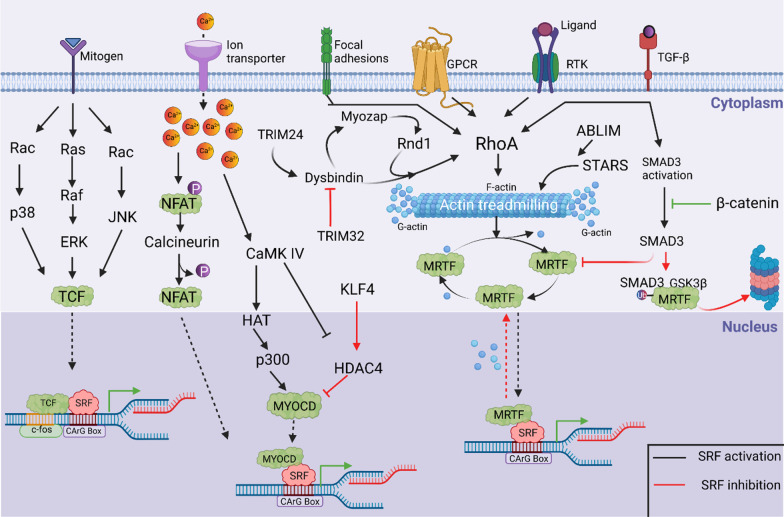Fig. 6.
Molecular mechanisms of SRF signal transduction. Multiple signaling pathways exhibit an effect on SRF transcriptional activation. TCF-mediated activation is mediated by a mitogen stimulus through the Ras-Raf-MAPK pathway, which leads to the activation of SRF-mediated cell proliferation- and differentiation-related genes. In calcium signaling, NFAT is dephosphorylated by the phosphatase Calcineurin, which facilitates NFAT nuclear localization, suggesting firm binding of MyocD-SRF, which mediates transcriptional activation. Additionally, calcium signaling activates Ca2+/calmodulin protein kinase, which further activates histone acetyltransferases, thereby facilitating MYOCD-SRF activation; this interaction is inhibited by multiple other factors, such as KLF4, HOP, and HDAC4, with the nuclear localization of HDAC4 inhibiting SRF-mediated transcription. Homeobox protein (HOP) has been known to inhibit the myocardin-SRF interaction, inhibiting transcriptional inactivation. Reports have also shown that Elk1 (a member of the Ets family of transcription factors) competes with MYOCD to competitively bind to SRF, affecting SRF-induced transcription. In addition, multiple receptors, such as G protein-coupled receptors (GPCRs), focal adhesions, receptor tyrosine kinases, and TGF-β, influence SRF transcription via the RhoA-Actin-MRTF signaling cascade. Smad3 activation via TGF-β signaling inhibits MRTF nuclear translocation and ubiquitin-mediated degradation of MRTF via the Smad3 and GSK3β axes. Multiple other molecules, such as dysbindin, myozap, and Rnd1, have been known to affect SRF signaling via the Rho-A-MRTF-SRF axis. MRTF in its active form is transported from the cytoplasm to the nucleus to induce SRF activation. Monomeric G-actin binds and inactivates MRTF, which is retained in the cytoplasm in the inactive actin-bound state. Thus, actin treadmilling controls MRTF-mediated SRF transcriptional activity. Furthermore, STARS can activate MRTF-SRF by controlling G- to -F actin polymerization. Ras, rat sarcoma; Raf, rapidly accelerated fibrosarcoma; Rac, Ras-related C3 botulinum toxin substrate; cdc42, cell division control protein 42; JNK, c-Jun N-terminal kinase; TCF, ternary complex factor; SRF, serum response factor; Ca2+, calcium, NFAT, nuclear factor of activated T cells; HOP, homeobox proteins; CaMKIV, calcium calmodulin-dependent protein kinase 4; HAT, histone acetyl transferases; MyocD, myocardin; KLF4, Kruppel-like facto 4; HDAC4, histone deacetylase 4; GPCR, G protein-coupled receptor; RTK, receptor tyrosine kinase; TGF-β, transforming growth factor-beta; GEFs, guanine nucleotide-exchange factors; ROCK, Rho-associated protein kinases; RhoA, Ras homolog family member A; LIMK, LIM kinase, STARS: striated muscle activators of Rho signaling; MRTF, myocardin-related transcription factor; GSK3β, glycogen synthase kinase 3 beta; ABLIM, actin binding LIM; TRIM24, tripartite motif containing 24; TRIM32, tripartite motif-containing 32; and P, phosphorylation

